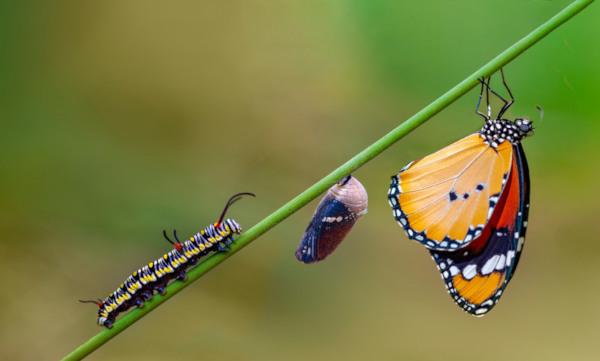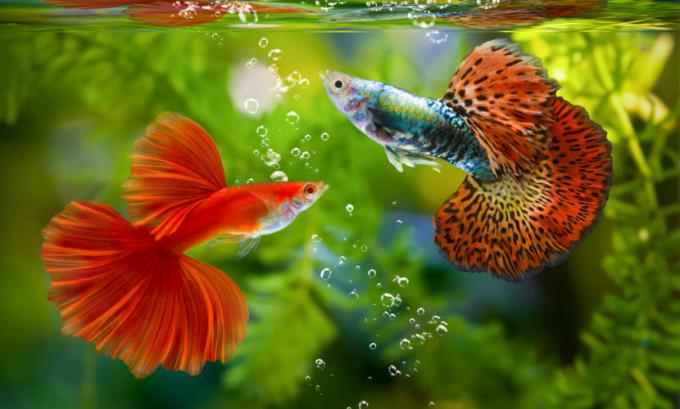THE metamorphosis of the butterflies is a fantastic event that shows us as a animal it may be different in your life stages. When we talk about metamorphosis, we are saying that these animals undergo changes in their bodies until they become adults. As their young and adult individuals are completely different, we say that the metamorphosis of butterflies is complete.
This type of metamorphosis ensures less competition between young people and adults in the same species, since they have very different lifestyle habits. Many people don't even know that butterflies and caterpillars are actually the same species at different stages of development.
Butterflies are animals that like the moths, form the Order Lepidoptera, one of the many orders of insects existing. Among the characteristics of these animals, we can mention the presence of two pairs of wings, which are covered with small scales, and the spirotromba, a long, coiled structure used in food. According to the Chico Mendes Institute for Biodiversity Conservation (ICMBio), Brazil has a great diversity of lepidopteran species, many of which are endemic.
Read too: Direct and indirect development in animals
How does butterfly metamorphosis occur
A butterfly's life can be divided into four stages: egg, larva(caterpillar), pupa (or chrysalis) and adult (imago). The immature and adult stages are completely different, which characterizes a complete metamorphosis. Next, we'll talk a little more about each one.
After fertilization, the adult female butterfly begins the search for where it will lay its eggs. Usually, the chosen locations are the leaves of a plant, which will generally be used as food when their offspring are born. The butterflies pay attention to the texture of the leaf in order to ensure that it will not break after laying eggs. You eggs are usually cylindrical and small. They take 5 to 15 days to hatch, depending on the species, and release the larvae, popularly known as caterpillars.
Caterpillars have an elongated and cylindrical body, with varied colors and, often, hairs that cause allergies and burns when touched. At caterpillar colors have different roles. Some have coloring that indicates danger, others have colors that make them confused with other species, and there are also those with colors that help in camouflage.
During the caterpillar stage, these animals feed intensively on different parts of vegetables, causing serious problems in places with plantations. It is from these leaves that the caterpillar extracts its nutrients and the Water what you need to survive. The butterfly is in the form of a caterpillar for approximately 1 to 8 months, depending on the species.

During the caterpillar stage, several molts occur as the animal grows, usually two to eight centimeters. After some time, the caterpillar attaches itself to a surface by the posterior portion of its body and by means of silk threads, and the formation of the chrysalis — an immobile stage, in which the animal survives thanks to the nutritional reserves accumulated in the caterpillar stage. the chrysalis stage can last from one to three weeks, depending on the species observed.
When the butterfly presents itself formed, the chrysalis opens and the insect can leave its interior. THE adult butterfly (or imago) is at a stage of life where can fly and reproduce, which does not occur in the other stages. Unlike the caterpillar stage, the adult butterfly feeds on substances in liquid form, such as nectar. flowers and fruits in decomposition, since it no longer has jaws, but a oral applianceaddicted to the habit of sucking. The adult stage can last from five days to a year, depending on the species.
The adult butterfly is the most beautiful stage of the animal due to its variety of colors that enchants any observer. It's almost impossible to believe she was once a caterpillar, is it?
Did you know that the color of the caterpillar does not determine the color of the adult butterfly? That way, if the caterpillar is green, the butterfly will not necessarily be green. Adult coloration is determined by genetic factors. |
Read too: Amphibians - meet another group of animals that undergo metamorphosis
Importance of Metamorphosis for Butterflies

Butterflies have complete metamorphosis, with immature and adult stages quite different from each other. This difference is important because each of these stages is specialized in different features, thus reducing competition..
While caterpillars feed on parts of vegetables, such as leaves, adult butterflies feed on nectar or fruit liquids. This is due to the fact that, at different stages of life, this animal has mouthparts adapted to different diets. While caterpillars have chewing mouthparts, butterflies have sucking mouthparts. We must also not forget that caterpillars are incapable of flying, unlike butterflies, which are active flying animals.



